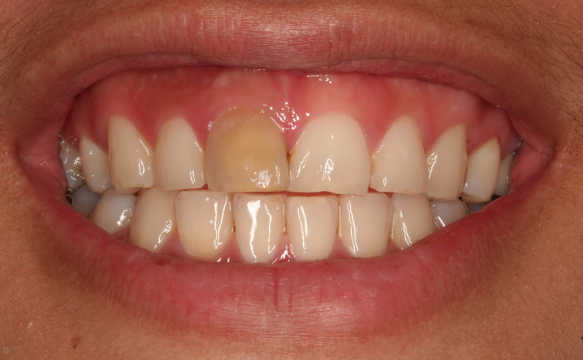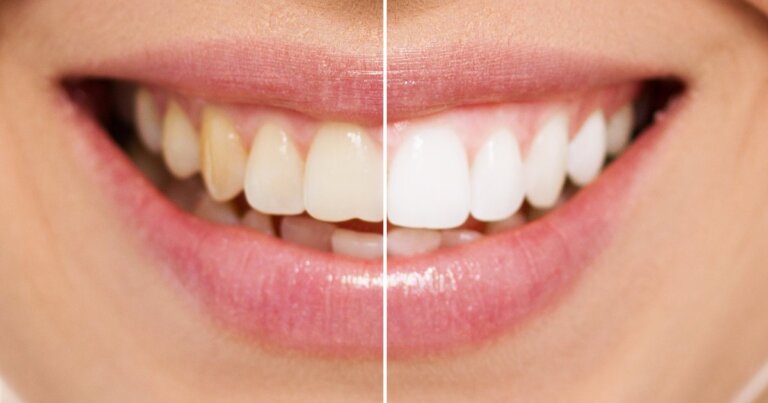Discolored Tooth

What Is A Discolored Tooth?
A Discolored Tooth is a tooth that has lost its natural color and appears darker or yellowish in shade. Discoloration can occur in one or more teeth, and it can be caused by a variety of factors, including poor dental hygiene, aging, genetics, and lifestyle habits.
Discolored teeth can affect a person’s confidence and self-esteem, and it is essential to understand the causes, prevention, and treatment options for this common dental issue. Before you contact a Toronto dentist to examine your Discolored Teeth, there are some things you should know as a patient:
- Why Do I Have A Discolored Tooth?
- Signs And Symptoms Of A Discolored Tooth
- Treatment Options For A Discolored Teeth
- How To Prevent A Discolored Teeth
- Managing A Discolored Teeth Until You Can See The Dentist
If you have questions about A Discolored Teeth or other dental problems, please contact us for more information.
Why Do I Have A Discolored Tooth?
There are many reasons why a person may have discolored teeth, including:
- Poor dental hygiene: Inadequate brushing, flossing, and regular dental cleanings can lead to plaque buildup and tooth discoloration. Thankfully, this can easily be reversed with routine dental cleaning and improved oral hygiene practices at home.
- Aging: It is a common phenomenon for teeth to get darker and more yellow as we age. This can happen for numerous reasons. For example, as we age, the enamel on our teeth naturally wears away, revealing the yellowish dentin layer underneath. Furthermore, the dental pulp inside the tooth can continue to lay down new dentin over time, which will cause the nerve inside the tooth to recede and make the tooth appear more yellow in color.
- Genetics: Some people may have naturally darker or thicker enamel, which can contribute to tooth discoloration. As it turns out, there are two genetic conditions known for causing inherent staining in teeth. This includes dentinogenesis imperfecta and amelogenesis imperfecta. Dentinogenesis imperfecta causes gray stains in teeth and makes them not only appear discolored, but transparent, weak, and brittle. It can affect both permanent teeth as well as baby teeth. Alternatively, amelogenesis imperfecta leads to yellow-brown stains as well as soft, fragile enamel. The condition can even lead to pitting and grooving, increasing the risk of decay, chipping, cracking, and breaking of teeth.
- Lifestyle habits: Consuming tooth staining substances such as coffee, tea, red wine, and tobacco products can lead to tooth discoloration. Thankfully, this can easily be reversed with routine dental cleaning.
- Trauma or injury: A tooth that has been injured or traumatized may turn dark or gray. This is because the tooth contains blood vessels. If a tooth gets traumatized, it can cause an internal bleed inside the tooth which will cause it to change color.
- Medications: Certain medications can cause tooth discoloration as a side effect. If you received the common antibiotics doxycycline or tetracycline as a child, your teeth may have discolored as a consequence. Antihistamines, high blood pressure medications, and antipsychotic drugs can also discolor teeth.
- Tooth decay: Dental decay can cause a gray or black colored discoloration of the affected tooth. The bacteria responsible for tooth decay produce acids that can dissolve the tooth enamel and cause cavities. If left untreated, the cavity can progress and become larger, and may require dental fillings or root canal treatment.
- Amalgam fillings: While they are an effective treatment for tooth decay, amalgam fillings can cause the surrounding tooth structure to turn gray or black over time. This occurs due to a chemical reaction between the filling and the tooth enamel.
Understanding the underlying cause of tooth discoloration is crucial in determining the appropriate treatment and prevention strategies. If you have further questions about what causes A Discolored Tooth, please contact us.
Signs And Symptoms Of A Discolored Tooth
Some common signs and symptoms of a discolored tooth may include:
- Yellow, brown, or grayish discoloration of the teeth: The most obvious sign of tooth discoloration is a change in the color of the tooth or teeth.
- Uneven color distribution: The discoloration may not be uniform, with some areas of the tooth appearing darker or lighter than others. You might have one tooth with a color imperfection that stands out from the rest of your teeth.
- Sensitivity: Some people may experience increased tooth sensitivity, especially to hot or cold temperatures. This is often an indication that the nerve inside the tooth is irritated.
- Pain: In some cases, tooth discoloration may be accompanied by pain or discomfort. Pain is usually an indication that there is a significant change or damage to a tooth which requires dental treatment.
- Rough or pitted surface: Discolored teeth may have a rough or pitted surface texture. This is common with genetic conditions known for causing inherent staining in teeth, such as dentinogenesis imperfecta and amelogenesis imperfecta.
If you notice any of these signs or symptoms, it’s important to consult with a dental professional to determine the underlying cause and appropriate treatment options. If you have further questions about the signs and symptoms of A Discolored Tooth, please contact us.
Treatment Options For A Discolored Tooth
Depending on the underlying cause of tooth discoloration, treatment options may include:
- Professional teeth whitening: This is a safe and effective way to lighten the color of your teeth due to aging effects, lifestyle habits, or genetic conditions. Your dentist uses a professional grade teeth bleaching agent and special laser light accelerator to remove surface stains and discoloration.
- Dental bonding: This involves applying a tooth-colored composite resin material to the surface of the tooth to improve its appearance. Dental bonding can be used to fix small chips, cracks, and gaps, as well as to cover up stains and discoloration. It is a simple and affordable option that can usually be completed in a single visit to the dentist.
- Porcelain veneers: Veneers are thin, custom-made shells that are bonded to the front of the teeth to improve their appearance. They can be used to cover up stains, discoloration, chips, and gaps, and can also improve the shape and size of the teeth. Veneers are a more permanent and expensive option than dental bonding, but they can provide a dramatic improvement in the appearance of the teeth.
- Crowns or bridges: If the discoloration is due to significant damage or decay to the tooth structure, your dentist may recommend a crown or bridge to restore the tooth’s natural appearance and function.
- Root canal treatment: If the tooth discoloration is due to dental trauma or injury, a root canal may be necessary to remove the damaged nerve tissue and relieve you of dentalpain. Afterwards, the tooth color can be improved with dental bonding, porcelain veneers, crowns or bridges.
- Replacement of amalgam fillings: If the discoloration is due to old silver or amalgam fillings, your dentist may recommend replacing them with tooth-colored composite fillings.
It’s important to consult with a dental professional to determine the most appropriate treatment options for your specific case of tooth discoloration. If you have further questions about treatment options for A Discolored Tooth, please contact us.

How To Prevent A Discolored Tooth
There are several steps you can take to prevent tooth discoloration, including:
- Practice good oral hygiene: Brush your teeth twice a day with a soft-bristled toothbrush and fluoride toothpaste. Floss daily to remove plaque and food particles from between your teeth and along the gum line. The Waterpik waterflosser is also a terrific adjunctive tool to keep your teeth healthy and clean.
- Use whitening toothpaste: Using whitening toothpastes such as Colgate Optic White Renewal or Crest 3D White can significantly reduce tooth and filling discoloration over time. The active ingredients are a patented hydrogen peroxide formula that is safe for enamel and will also whiten your teeth. They can be purchased at your local pharmacy or online.
- Avoid smoking or using tobacco products: Smoking and using tobacco products can cause yellow or brown stains on teeth, as well as other oral health problems.
- Limit staining foods and beverages: Foods and beverages such as coffee, tea, red wine, and dark-colored berries can stain teeth over time. It’s important to consume these in moderation and to rinse your mouth with water or brush your teeth after consuming them.
- Use a drinking straw: When drinking beverages that can stain your teeth, using a straw can help minimize contact between the liquid and your teeth.
- Visit your dentist regularly: Regular dental checkups and teeth cleanings can help remove surface stains and detect any underlying issues that may be causing tooth discoloration.
By taking these steps, you can help keep your teeth looking bright and healthy for years to come. If you have further questions about how to prevent A Discolored Tooth, please contact us.
Managing A Discolored Tooth Until You Can See The Dentist
If you’re experiencing tooth discoloration and are unable to see a dentist right away, there are a few things you can do to manage the issue:
- Practice good oral hygiene: Brush your teeth twice a day with a soft-bristled toothbrush and fluoride toothpaste. Floss daily to remove plaque and food particles from between your teeth and along the gum line. The Waterpik waterflosser is also a terrific adjunctive tool to keep your teeth healthy and clean.
- Use whitening toothpaste: Using whitening toothpastes such as Colgate Optic White Renewal can significantly reduce tooth and filling discoloration over time. The active ingredients are a patented hydrogen peroxide formula that is safe for enamel and will also whiten your teeth. They can be purchased at your local pharmacy or online.
- Try an at-home teeth whitening kit: Over-the-counter whitening kits, such as Crest 3DWhitestrips, can help remove surface stains and lighten the color of your teeth. However, it is important to follow the instructions carefully and note that results may vary. At home whitening kits may not have the same results as professionally applied teeth whitening gels.
- Avoid smoking or using tobacco products: Smoking and using tobacco products can cause yellow or brown stains on teeth, as well as other oral health problems.
- Limit staining foods and beverages: Foods and beverages such as coffee, tea, red wine, and dark-colored berries can stain teeth over time. It’s important to consume these in moderation and to rinse your mouth with water or brush your teeth after consuming them.
- Use a drinking straw: When drinking beverages that can stain your teeth, using a straw can help minimize contact between the liquid and your teeth.
While these methods can help manage tooth discoloration temporarily, it’s important to see a dentist as soon as possible to identify and address the underlying cause of the discoloration. If you have further questions about managing A Discolored Tooth, please contact us.

